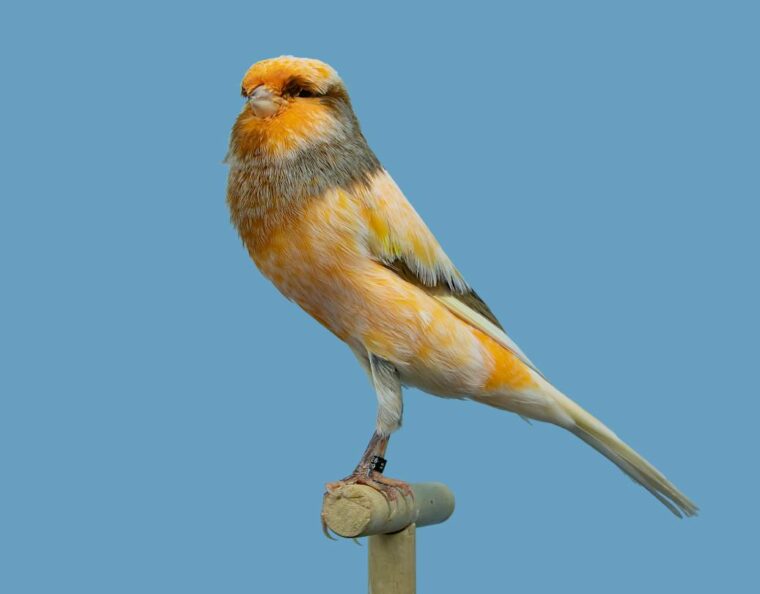
In the canary world, none are nobler than the Yorkshire Canary. Taller than other canaries, this breed is broad-chested and sits up tall. They are often referred to as the Guardsman or the Gentleman of the Fancy due to their unique shape and stature. As a broad-chested bird, this canary is known for its beautiful songs. In their early years, they were regarded by royals for this reason. While the Yorkshire is like other canaries in that it is easy to care for and makes a great companion for people who are new to owning birds, they are also a unique breed that isn’t readily available at your local pet store. Let’s learn more about these beautiful birds so you can decide if one is perfect for your home.
Species Overview
| Common Names: | Yorkshire Canary, Gentleman of the Fancy, Guardsman |
| Scientific Name: | Serinus canaria domesticus |
| Adult Size: | 6 ¾ inches tall |
| Life Expectancy: | 12 to 15 years |
Origin and History
The Yorkshire Canary was developed in the mid-1800s. This species originated by crossbreeding Norwich, Lancashire, and Belgian canaries. The Yorkshire was created to add qualities such as length, vigor, stance, and improved feather and color quality to its parent breeds. The result of this crossbreeding was first shown in Yorkshire in 1870 and is where this breed got its name. The Yorkshire Canary Club was developed in 1894 in hopes of determining the desired traits and types that would be accepted for the breed. It wasn’t until 1935 that the “desired” standards were determined.
Temperament
The Yorkshire Canary is considered a relatively calm-natured bird. They are timid birds that do well in large cages and even aviaries. However, they should not be housed with other birds that can be temperamental or aggressive. Males of the species do tend to be territorial. It is best to avoid housing two Yorkshire Canaries in the same cage. Large aviaries should be fine but close they will fight.
Speech & Vocalizations
As a large-chested bird, the Yorkshire Canary has a beautiful singing voice. Both males and females of this breed can sing but it is mostly the males. After the species’ development, royals and people of stature wanted these large birds simply to hear the beautiful sound of their songs. Yorkshires also communicate with one another and their owners using chirps. It’s the versatility and strong vocalization of these birds that make them so popular as pets.
Yorkshire Canary Colors and Markings
The Yorkshire Canary is a large-chested bird that is tall and features an erect stance. The bird narrows in the waist and is often compared to clock hands at five past seven. Yorkshire Canaries can be orange, brown, yellow, cinnamon, green, and white. A white Yorkshire Canary is considered the rarest color variation of the breed.
Caring for the Yorkshire Canary
One thing to keep in mind when it comes to the Yorkshire Canary in comparison to other canaries is its size. Yorkshires are taller and require more space. This means they need larger cages to be content. Canaries enjoy flying so make sure your Yorkshire has enough space to do this without injuring itself. You’ll also need to keep the cage in an area away from drafts and heat sources. Room temperature is ideal for the Yorkshire. The last thing you want is for them to get too hot or too cold.
Like other canaries, this species does well alone. They aren’t prone to issues with loneliness. However, if you do decide to house two Yorkshires together, having the opposite sex can lower the potential for territorial fights. You’ll need a shallow dish for water or a bath since Yorkshires enjoy bathing from time to time. Perches and swings are ideal and are where these birds spend most of their time. Canaries don’t require a lot of special attention from their owners, which is why they are so popular. You should make sure they get enough rest, providing light and dark cycles by covering the cage at night. Cage cleaning and nail trimming are needed for this and any canary species.
Common Health Problems
The biggest concerns Yorkshires and other canary species face often are a result of the owner. When cages are left dirty or kept in drafty rooms, birds can get sick. It’s also important to know that canary breeds are susceptible to air quality issues and shouldn’t be exposed to smoke or vapors in the home.
Like other bird species, Yorkshire Canaries can become infected with fungi, bacteria, and viruses. Bumblefoot and yeast infections are among the most common. You should always attempt to keep your bird healthy by providing them with the right diet and proper shelter. If issues arise, immediately take your canary to the veterinarian for proper treatment.
Diet and Nutrition
A high-quality seed mixture is the best option for canaries. This is the closest to what they would have eaten in the wild. Remember, however, that it is up to you to remove hulls from your canary’s dish daily so they can easily access the rest of their food. Purchase a seed mixture that is designed for canaries to ensure they are getting the proper nutrition. Also, remember to provide your canary with fresh water at all times.
Canaries also enjoy green veggies and a few fruits. Kale, spinach, broccoli, dandelion, and peas are a few of the veggies you can offer your Yorkshire. Apples, grapes, oranges, and melons are also treats they will enjoy. If you want to provide your Yorkshire with added protein, they enjoy hard-boiled egg bits.
Exercise
Every bird needs exercise. A Yorkshire is a simple bird, however. If you have perches, perhaps a bell or mirror, and a bath inside the cage they are happy. With their larger size, they need the freedom to move around so avoid overloading the cage. After your bird has gotten accustomed to you, allowing them to fly around the room is possible with training. Always make sure windows and doors are closed and fans are turned off if you allow your Yorkshire to leave its cage.
 Where to Adopt or Buy a Yorkshire Canary
Where to Adopt or Buy a Yorkshire Canary
Yorkshire Canaries are considered a specialty breed. This means you may not find one at your local pet store. Instead, contacting responsible breeders, canary clubs, and bird shows may be your best option. You may find ways to purchase these birds online but always proceed with caution if you are unfamiliar with the site.
Conclusion
As you can see, the Yorkshire Canary is a beautiful bird that is perfect for those new to the avian world. They are larger than other canaries, hardy, and provide owners with beautiful songs and company. If you’re interested in adding one of these birds to your home, be prepared. They are considered specialty birds and are usually purchased through breeders or other canary enthusiasts.
Featured Image Credit: Fernando Zamora Vega, Shutterstock









